Yoobi: Applying Kapferer's Brand Identity Prism for Analysis
VerifiedAdded on 2020/05/28
|7
|1375
|177
Report
AI Summary
This report provides a comprehensive analysis of the Yoobi brand, a stationery company operating in the United States and Australia, using the Kapferer Brand Identity Prism. The analysis examines six key components: brand physique (appearance and features), brand personality (character and communication style), brand culture (values and influences), relationship (interactions with customers), reflection (customer perception), and self-image (target audience). The report details how Yoobi's products, designed for children and stationery enthusiasts, reflect these elements. Yoobi's commitment to corporate social responsibility, donating a portion of each purchase to charity, is also highlighted. The brand is positioned as attractive, environmentally friendly, and socially conscious, with a focus on appealing to a creative and artistic audience.

Running head: YOOBI
YOOBI
Name of the Student
Name of the University
Author Note
YOOBI
Name of the Student
Name of the University
Author Note
Paraphrase This Document
Need a fresh take? Get an instant paraphrase of this document with our AI Paraphraser
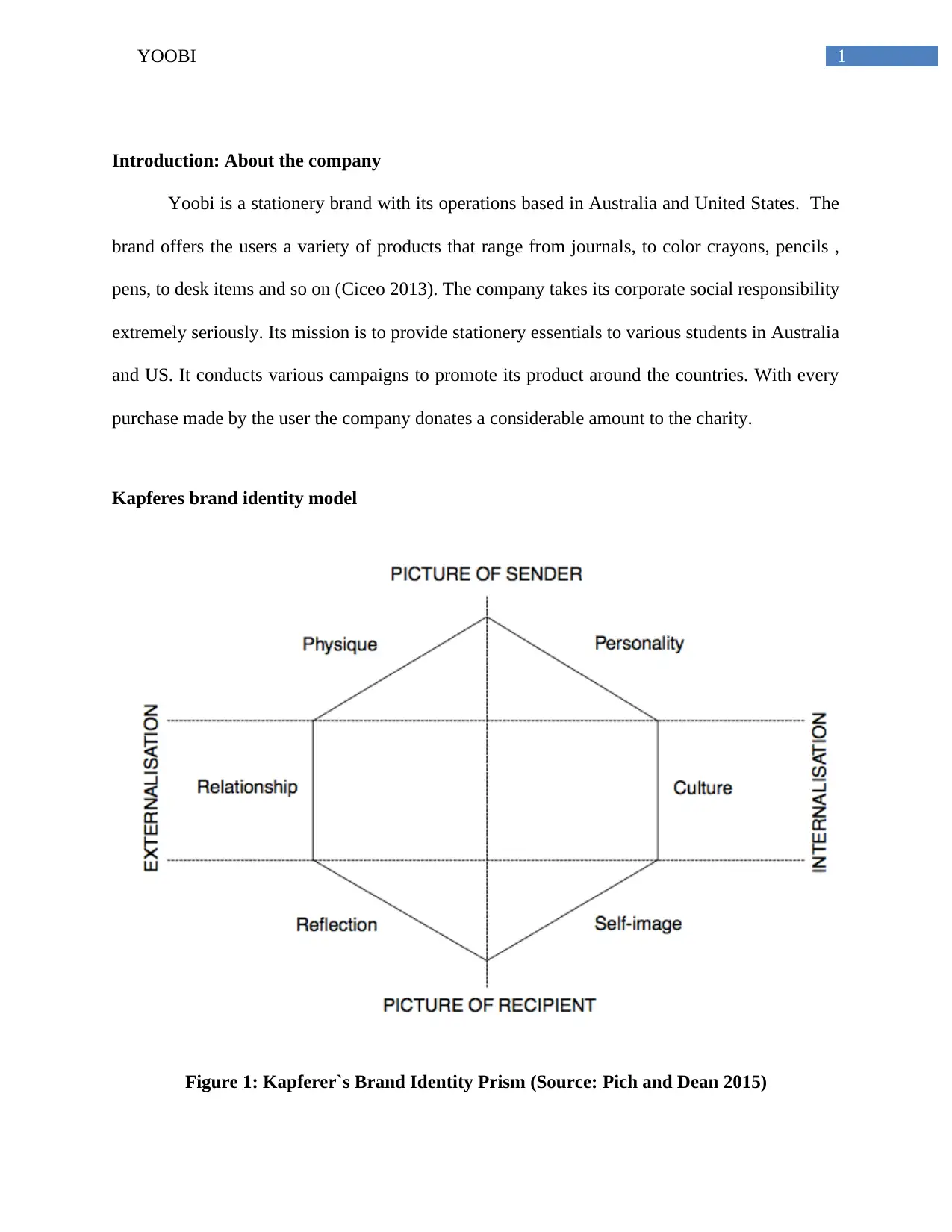
1YOOBI
Introduction: About the company
Yoobi is a stationery brand with its operations based in Australia and United States. The
brand offers the users a variety of products that range from journals, to color crayons, pencils ,
pens, to desk items and so on (Ciceo 2013). The company takes its corporate social responsibility
extremely seriously. Its mission is to provide stationery essentials to various students in Australia
and US. It conducts various campaigns to promote its product around the countries. With every
purchase made by the user the company donates a considerable amount to the charity.
Kapferes brand identity model
Figure 1: Kapferer`s Brand Identity Prism (Source: Pich and Dean 2015)
Introduction: About the company
Yoobi is a stationery brand with its operations based in Australia and United States. The
brand offers the users a variety of products that range from journals, to color crayons, pencils ,
pens, to desk items and so on (Ciceo 2013). The company takes its corporate social responsibility
extremely seriously. Its mission is to provide stationery essentials to various students in Australia
and US. It conducts various campaigns to promote its product around the countries. With every
purchase made by the user the company donates a considerable amount to the charity.
Kapferes brand identity model
Figure 1: Kapferer`s Brand Identity Prism (Source: Pich and Dean 2015)
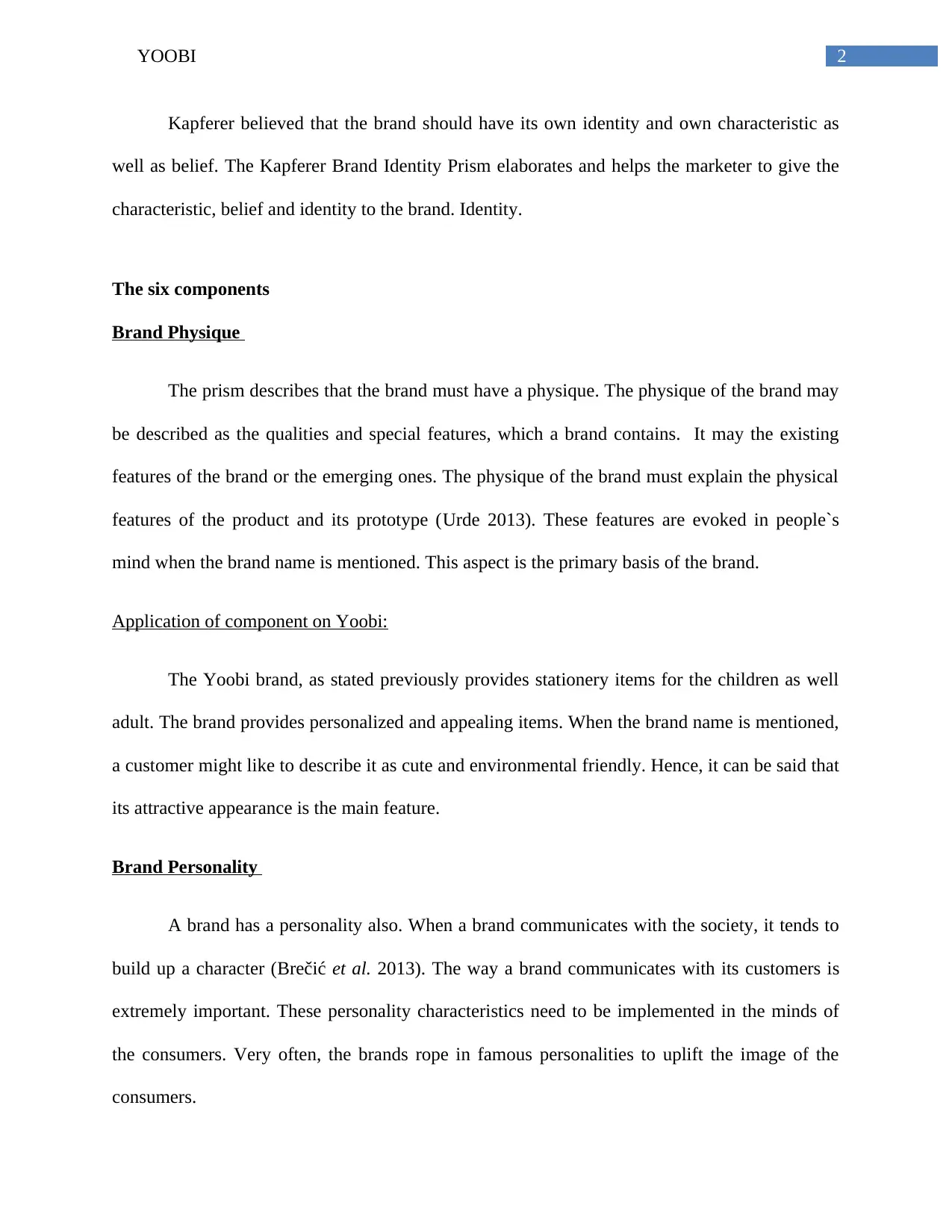
2YOOBI
Kapferer believed that the brand should have its own identity and own characteristic as
well as belief. The Kapferer Brand Identity Prism elaborates and helps the marketer to give the
characteristic, belief and identity to the brand. Identity.
The six components
Brand Physique
The prism describes that the brand must have a physique. The physique of the brand may
be described as the qualities and special features, which a brand contains. It may the existing
features of the brand or the emerging ones. The physique of the brand must explain the physical
features of the product and its prototype (Urde 2013). These features are evoked in people`s
mind when the brand name is mentioned. This aspect is the primary basis of the brand.
Application of component on Yoobi:
The Yoobi brand, as stated previously provides stationery items for the children as well
adult. The brand provides personalized and appealing items. When the brand name is mentioned,
a customer might like to describe it as cute and environmental friendly. Hence, it can be said that
its attractive appearance is the main feature.
Brand Personality
A brand has a personality also. When a brand communicates with the society, it tends to
build up a character (Brečić et al. 2013). The way a brand communicates with its customers is
extremely important. These personality characteristics need to be implemented in the minds of
the consumers. Very often, the brands rope in famous personalities to uplift the image of the
consumers.
Kapferer believed that the brand should have its own identity and own characteristic as
well as belief. The Kapferer Brand Identity Prism elaborates and helps the marketer to give the
characteristic, belief and identity to the brand. Identity.
The six components
Brand Physique
The prism describes that the brand must have a physique. The physique of the brand may
be described as the qualities and special features, which a brand contains. It may the existing
features of the brand or the emerging ones. The physique of the brand must explain the physical
features of the product and its prototype (Urde 2013). These features are evoked in people`s
mind when the brand name is mentioned. This aspect is the primary basis of the brand.
Application of component on Yoobi:
The Yoobi brand, as stated previously provides stationery items for the children as well
adult. The brand provides personalized and appealing items. When the brand name is mentioned,
a customer might like to describe it as cute and environmental friendly. Hence, it can be said that
its attractive appearance is the main feature.
Brand Personality
A brand has a personality also. When a brand communicates with the society, it tends to
build up a character (Brečić et al. 2013). The way a brand communicates with its customers is
extremely important. These personality characteristics need to be implemented in the minds of
the consumers. Very often, the brands rope in famous personalities to uplift the image of the
consumers.
⊘ This is a preview!⊘
Do you want full access?
Subscribe today to unlock all pages.

Trusted by 1+ million students worldwide
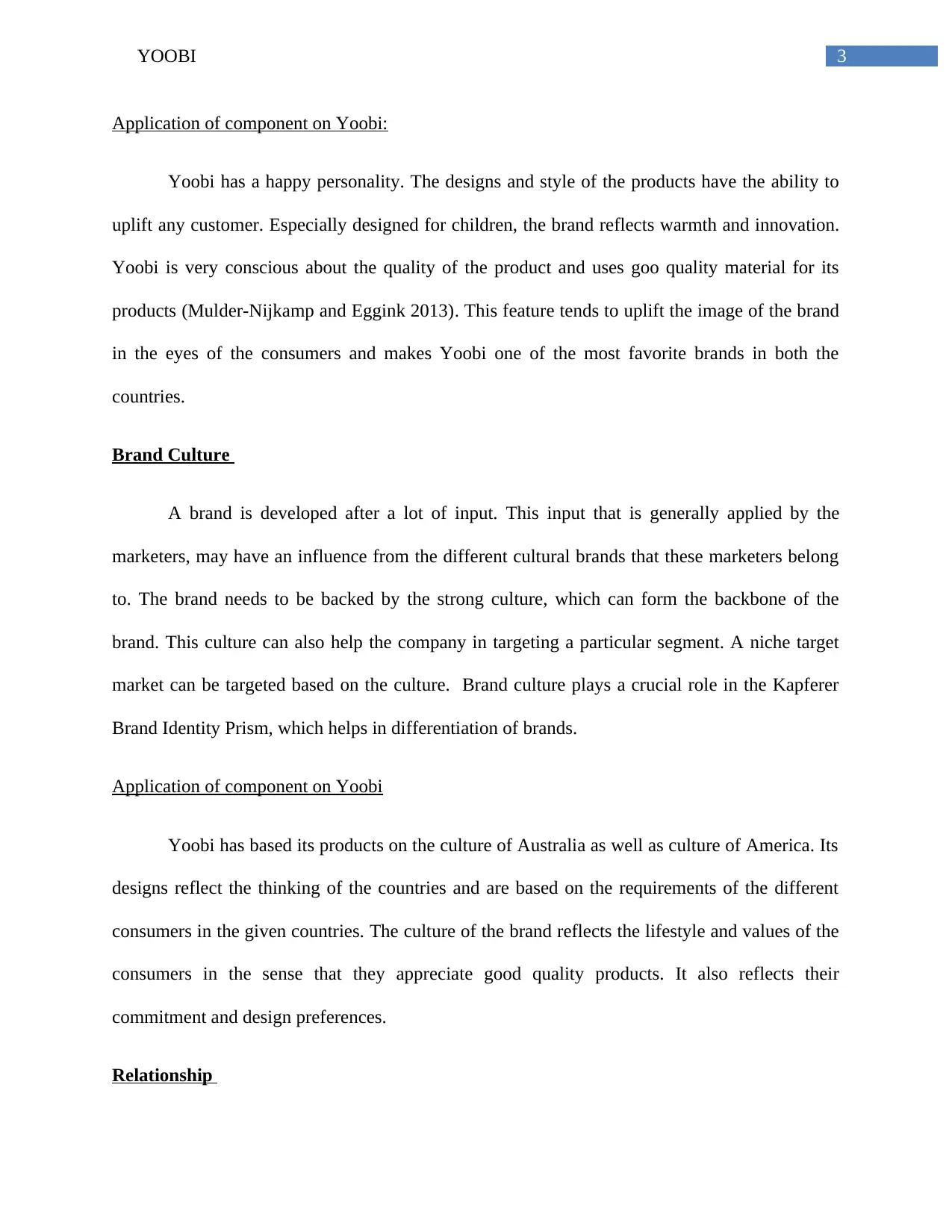
3YOOBI
Application of component on Yoobi:
Yoobi has a happy personality. The designs and style of the products have the ability to
uplift any customer. Especially designed for children, the brand reflects warmth and innovation.
Yoobi is very conscious about the quality of the product and uses goo quality material for its
products (Mulder-Nijkamp and Eggink 2013). This feature tends to uplift the image of the brand
in the eyes of the consumers and makes Yoobi one of the most favorite brands in both the
countries.
Brand Culture
A brand is developed after a lot of input. This input that is generally applied by the
marketers, may have an influence from the different cultural brands that these marketers belong
to. The brand needs to be backed by the strong culture, which can form the backbone of the
brand. This culture can also help the company in targeting a particular segment. A niche target
market can be targeted based on the culture. Brand culture plays a crucial role in the Kapferer
Brand Identity Prism, which helps in differentiation of brands.
Application of component on Yoobi
Yoobi has based its products on the culture of Australia as well as culture of America. Its
designs reflect the thinking of the countries and are based on the requirements of the different
consumers in the given countries. The culture of the brand reflects the lifestyle and values of the
consumers in the sense that they appreciate good quality products. It also reflects their
commitment and design preferences.
Relationship
Application of component on Yoobi:
Yoobi has a happy personality. The designs and style of the products have the ability to
uplift any customer. Especially designed for children, the brand reflects warmth and innovation.
Yoobi is very conscious about the quality of the product and uses goo quality material for its
products (Mulder-Nijkamp and Eggink 2013). This feature tends to uplift the image of the brand
in the eyes of the consumers and makes Yoobi one of the most favorite brands in both the
countries.
Brand Culture
A brand is developed after a lot of input. This input that is generally applied by the
marketers, may have an influence from the different cultural brands that these marketers belong
to. The brand needs to be backed by the strong culture, which can form the backbone of the
brand. This culture can also help the company in targeting a particular segment. A niche target
market can be targeted based on the culture. Brand culture plays a crucial role in the Kapferer
Brand Identity Prism, which helps in differentiation of brands.
Application of component on Yoobi
Yoobi has based its products on the culture of Australia as well as culture of America. Its
designs reflect the thinking of the countries and are based on the requirements of the different
consumers in the given countries. The culture of the brand reflects the lifestyle and values of the
consumers in the sense that they appreciate good quality products. It also reflects their
commitment and design preferences.
Relationship
Paraphrase This Document
Need a fresh take? Get an instant paraphrase of this document with our AI Paraphraser
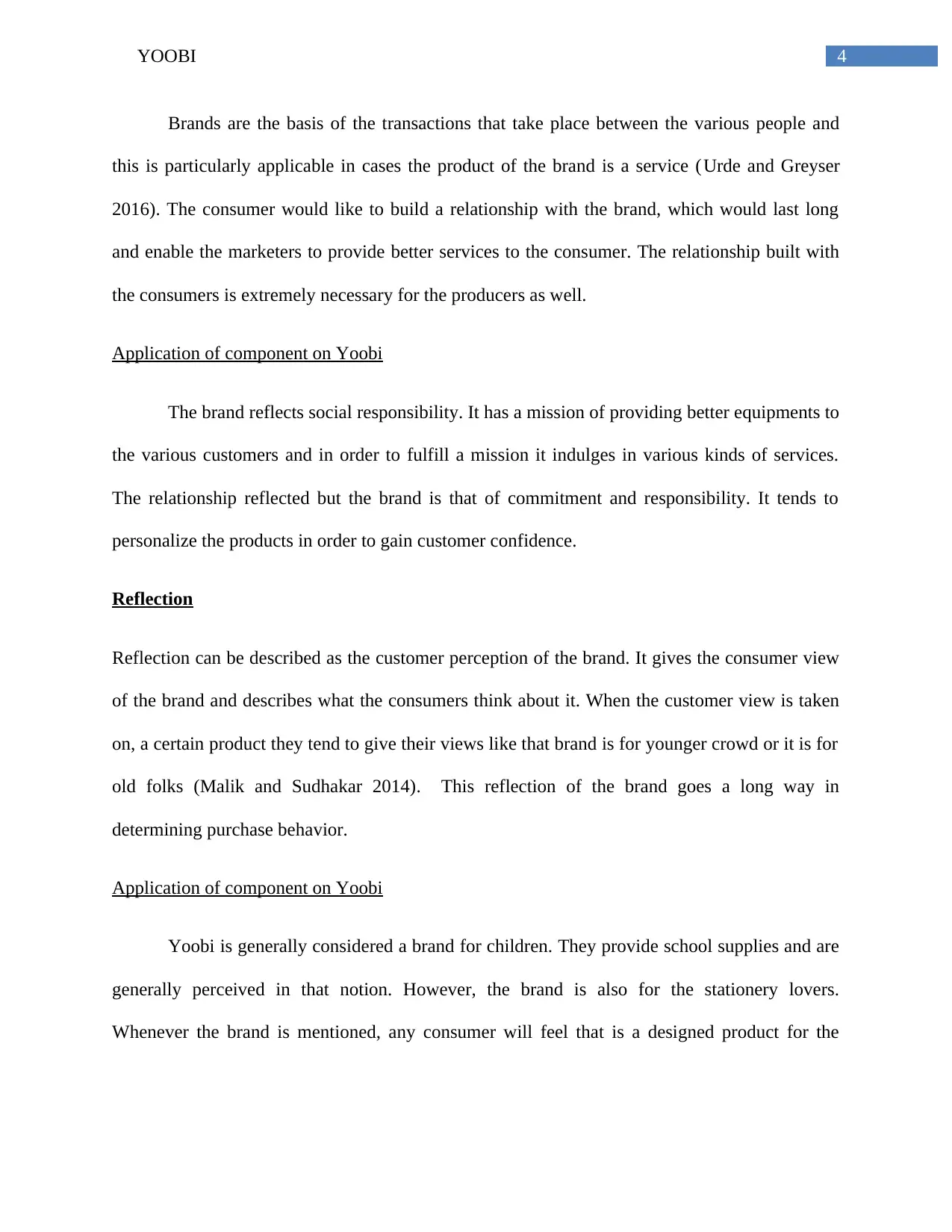
4YOOBI
Brands are the basis of the transactions that take place between the various people and
this is particularly applicable in cases the product of the brand is a service (Urde and Greyser
2016). The consumer would like to build a relationship with the brand, which would last long
and enable the marketers to provide better services to the consumer. The relationship built with
the consumers is extremely necessary for the producers as well.
Application of component on Yoobi
The brand reflects social responsibility. It has a mission of providing better equipments to
the various customers and in order to fulfill a mission it indulges in various kinds of services.
The relationship reflected but the brand is that of commitment and responsibility. It tends to
personalize the products in order to gain customer confidence.
Reflection
Reflection can be described as the customer perception of the brand. It gives the consumer view
of the brand and describes what the consumers think about it. When the customer view is taken
on, a certain product they tend to give their views like that brand is for younger crowd or it is for
old folks (Malik and Sudhakar 2014). This reflection of the brand goes a long way in
determining purchase behavior.
Application of component on Yoobi
Yoobi is generally considered a brand for children. They provide school supplies and are
generally perceived in that notion. However, the brand is also for the stationery lovers.
Whenever the brand is mentioned, any consumer will feel that is a designed product for the
Brands are the basis of the transactions that take place between the various people and
this is particularly applicable in cases the product of the brand is a service (Urde and Greyser
2016). The consumer would like to build a relationship with the brand, which would last long
and enable the marketers to provide better services to the consumer. The relationship built with
the consumers is extremely necessary for the producers as well.
Application of component on Yoobi
The brand reflects social responsibility. It has a mission of providing better equipments to
the various customers and in order to fulfill a mission it indulges in various kinds of services.
The relationship reflected but the brand is that of commitment and responsibility. It tends to
personalize the products in order to gain customer confidence.
Reflection
Reflection can be described as the customer perception of the brand. It gives the consumer view
of the brand and describes what the consumers think about it. When the customer view is taken
on, a certain product they tend to give their views like that brand is for younger crowd or it is for
old folks (Malik and Sudhakar 2014). This reflection of the brand goes a long way in
determining purchase behavior.
Application of component on Yoobi
Yoobi is generally considered a brand for children. They provide school supplies and are
generally perceived in that notion. However, the brand is also for the stationery lovers.
Whenever the brand is mentioned, any consumer will feel that is a designed product for the
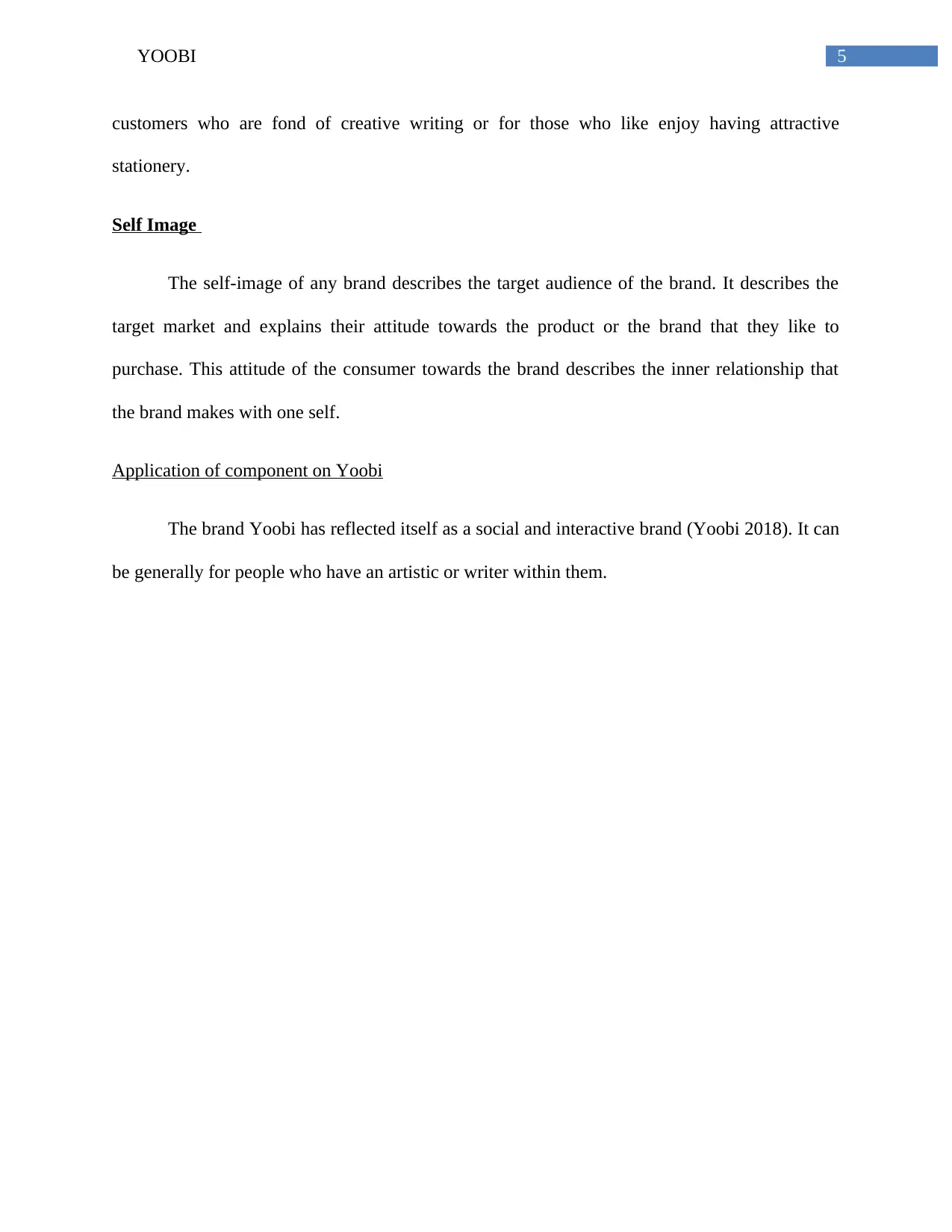
5YOOBI
customers who are fond of creative writing or for those who like enjoy having attractive
stationery.
Self Image
The self-image of any brand describes the target audience of the brand. It describes the
target market and explains their attitude towards the product or the brand that they like to
purchase. This attitude of the consumer towards the brand describes the inner relationship that
the brand makes with one self.
Application of component on Yoobi
The brand Yoobi has reflected itself as a social and interactive brand (Yoobi 2018). It can
be generally for people who have an artistic or writer within them.
customers who are fond of creative writing or for those who like enjoy having attractive
stationery.
Self Image
The self-image of any brand describes the target audience of the brand. It describes the
target market and explains their attitude towards the product or the brand that they like to
purchase. This attitude of the consumer towards the brand describes the inner relationship that
the brand makes with one self.
Application of component on Yoobi
The brand Yoobi has reflected itself as a social and interactive brand (Yoobi 2018). It can
be generally for people who have an artistic or writer within them.
⊘ This is a preview!⊘
Do you want full access?
Subscribe today to unlock all pages.

Trusted by 1+ million students worldwide
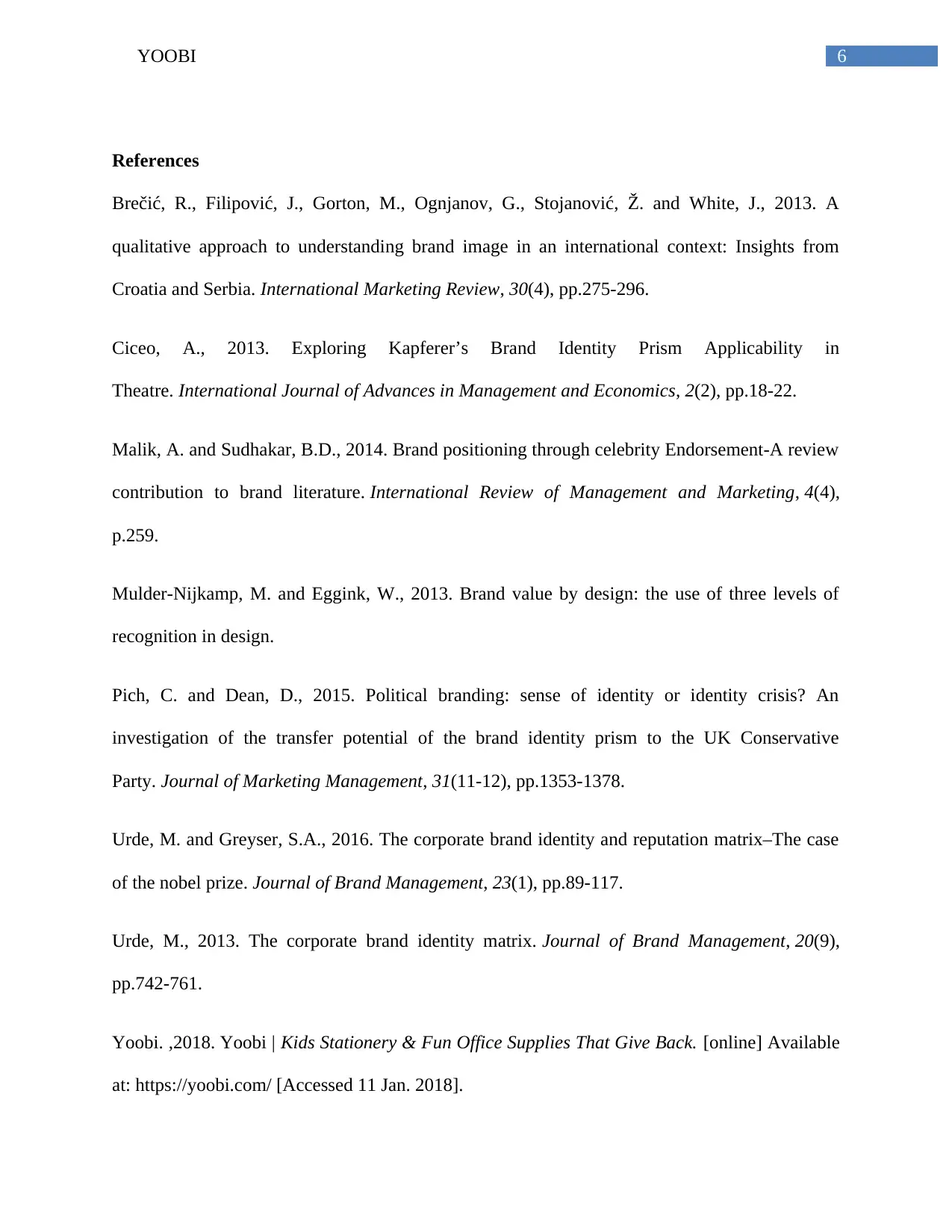
6YOOBI
References
Brečić, R., Filipović, J., Gorton, M., Ognjanov, G., Stojanović, Ž. and White, J., 2013. A
qualitative approach to understanding brand image in an international context: Insights from
Croatia and Serbia. International Marketing Review, 30(4), pp.275-296.
Ciceo, A., 2013. Exploring Kapferer’s Brand Identity Prism Applicability in
Theatre. International Journal of Advances in Management and Economics, 2(2), pp.18-22.
Malik, A. and Sudhakar, B.D., 2014. Brand positioning through celebrity Endorsement-A review
contribution to brand literature. International Review of Management and Marketing, 4(4),
p.259.
Mulder-Nijkamp, M. and Eggink, W., 2013. Brand value by design: the use of three levels of
recognition in design.
Pich, C. and Dean, D., 2015. Political branding: sense of identity or identity crisis? An
investigation of the transfer potential of the brand identity prism to the UK Conservative
Party. Journal of Marketing Management, 31(11-12), pp.1353-1378.
Urde, M. and Greyser, S.A., 2016. The corporate brand identity and reputation matrix–The case
of the nobel prize. Journal of Brand Management, 23(1), pp.89-117.
Urde, M., 2013. The corporate brand identity matrix. Journal of Brand Management, 20(9),
pp.742-761.
Yoobi. ,2018. Yoobi | Kids Stationery & Fun Office Supplies That Give Back. [online] Available
at: https://yoobi.com/ [Accessed 11 Jan. 2018].
References
Brečić, R., Filipović, J., Gorton, M., Ognjanov, G., Stojanović, Ž. and White, J., 2013. A
qualitative approach to understanding brand image in an international context: Insights from
Croatia and Serbia. International Marketing Review, 30(4), pp.275-296.
Ciceo, A., 2013. Exploring Kapferer’s Brand Identity Prism Applicability in
Theatre. International Journal of Advances in Management and Economics, 2(2), pp.18-22.
Malik, A. and Sudhakar, B.D., 2014. Brand positioning through celebrity Endorsement-A review
contribution to brand literature. International Review of Management and Marketing, 4(4),
p.259.
Mulder-Nijkamp, M. and Eggink, W., 2013. Brand value by design: the use of three levels of
recognition in design.
Pich, C. and Dean, D., 2015. Political branding: sense of identity or identity crisis? An
investigation of the transfer potential of the brand identity prism to the UK Conservative
Party. Journal of Marketing Management, 31(11-12), pp.1353-1378.
Urde, M. and Greyser, S.A., 2016. The corporate brand identity and reputation matrix–The case
of the nobel prize. Journal of Brand Management, 23(1), pp.89-117.
Urde, M., 2013. The corporate brand identity matrix. Journal of Brand Management, 20(9),
pp.742-761.
Yoobi. ,2018. Yoobi | Kids Stationery & Fun Office Supplies That Give Back. [online] Available
at: https://yoobi.com/ [Accessed 11 Jan. 2018].
1 out of 7
Related Documents
Your All-in-One AI-Powered Toolkit for Academic Success.
+13062052269
info@desklib.com
Available 24*7 on WhatsApp / Email
![[object Object]](/_next/static/media/star-bottom.7253800d.svg)
Unlock your academic potential
Copyright © 2020–2025 A2Z Services. All Rights Reserved. Developed and managed by ZUCOL.





